Ole Gunnar Solskjær is now the first Manchester United manager since Sir Alex Ferguson to complete a Premier League double over Manchester City. With 70% possession, the recently crowned Carabao Cup Champions initially appeared to be in full control; however, It was the men in red that had more to say in controlling the game out of possession. Reducing the Citizens to just four attempts on target and an xG rating of 0.61, Manchester United found the reward for their defensive resolve. Helped by Ederson’s errors for both goals, the Red Devil’s silence the Pep Guardiola’s goal machine in this derby to walk away with all three points. Final score, Manchester United 2 – 0 Manchester City.
The tactical analysis below tells the story of the game from a tactical standpoint. Considering the game plan set out by both managers, as well as key players and tactical changes throughout the game, we look at where the game might have been won or lost. In this analysis, with the support of key data and statistics, we also highlight the most prominent aspects of both teams’ style of play.
Lineup
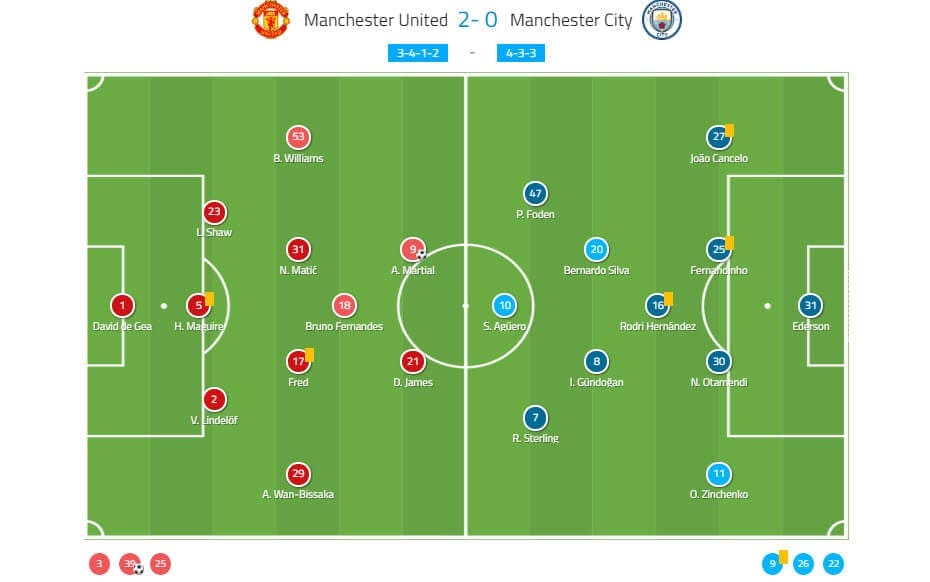
Manchester United: 3-4-1-2
Ole Gunnar Solskjær made two changes to the side that drew away to Everton in the previous game week. Scott McTominay and Mason Greenwood make way for 19-year-old Brandon Willams at left-wing-back and Daniel James who partnered Anthony Martial up front. Still, no Paul Pogba to strengthen the bench however new signing Odion Ighalo featured late in the game along with Eric Bailly and McTominay.
Manchester City: 4-3-3
Guardiola made four changes to the side that collected three points away to Aston Villa last week. Kyle Walker and John Stones depart from the backline to allow João Cancelo and Nicolás Otamendi to slot in at right-back and centre-back respectively. A significant loss in midfield as Kevin De Bruyne is sidelined through injury, so only one change is made to the dynamic trio in midfield as the Silva’s rotate. David Silva makes way for Bernardo Silva to play in front of holding midfielder Rodrigo Hernández and alongside İlkay Gündoğan. The fourth and final change happens between the posts as Claudio Bravo makes way for Ederson. Gabriel Jesus and Riyad Mahrez come off the bench early in the second to offer more pace in the attack while Benjamin Mendy is introduced later in the game to provide City chances to score from crosses.
City control but no penetration
Martialling the game with 70% possession and a high tempo of horizontal passes, the Sky Blues played some stylish football up until the final third. In typical Manchester City fashion, they summoned their opponents to relinquish a high *PPDA average of 26 passes as they looked to create and exploit openings by stretching the Manchester United backline with fast, fluid possession football.
For reasons we will highlight below, City did not have all their way. Achieving 61 attacks across the 90 minutes, and a lot of those starting from deeper positions on the field, only 10% developed into attempts on goal.
*PPDA: Passes Per Defensive Action, a metric to establish an average of how many passes the opponent makes before a successful defensive action meets them.
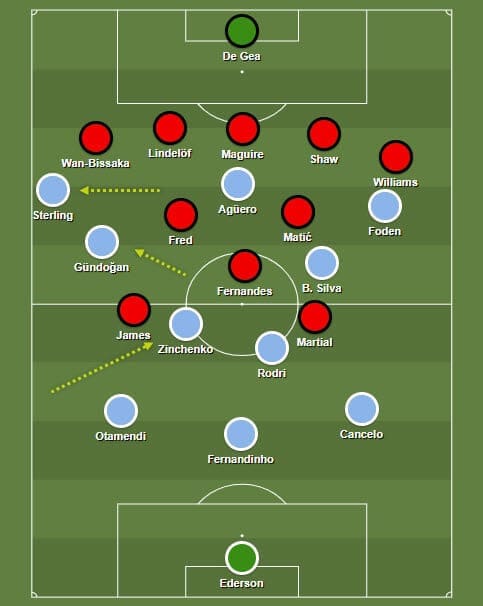
Above, we see a balanced representation of both teams while Manchester City was in the offensive phase. Although City’s organisation is not A-symmetrical, notice Raheem Sterling holds his width while Oleksandr Zinchenko plays as an inverted full-back. Zinchenko plays more central in the offensive phase than the inside midfielder Gündoğan, this is to create a central overload in midfield as well as to unbalance the United midfield in the half-spaces.
Right-footer Sterling played as the left forward while left-footed Phil Foden played on the right. Sterling has more of ‘1-v-1’ role in beating the last defender and entering the box while Foden would carry the ball inside from a wide position to play penetrating passes through the half-space or play a reverse pass out wide to the supporting right-back Cancelo or Bernardo.
City’s top goalscorer this season Sergio Agüero (23) plays as the target man, as he seldom drifted wide or into midfield to create attacking opportunities his function was limited to linking with teammates on the edge of the box and meeting penetrating passes and crosses.
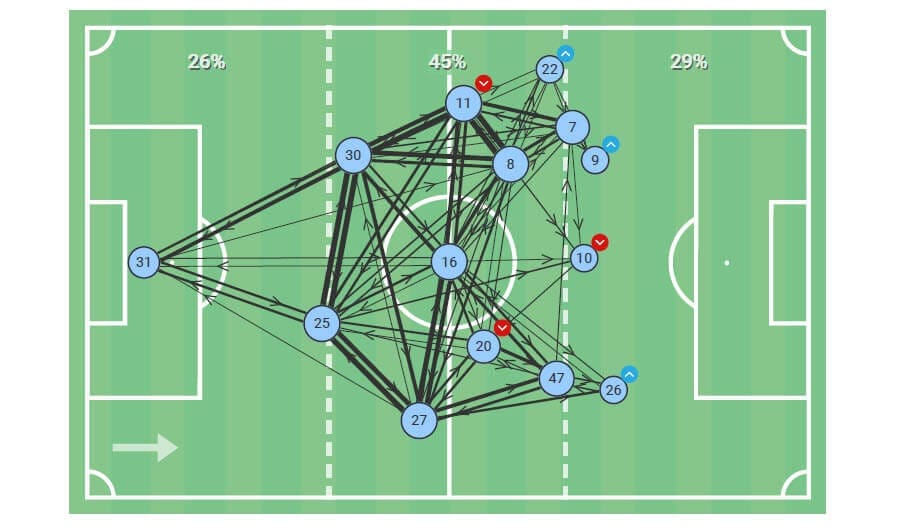
Above we see the passing network of Manchester City, accounting for combinations of three or more passes the data represents each player’s average position when in possession of the ball. Observe the density and balance of the lines between both full-backs and central-midfielders along with their equal distances from each other. Accounting for City’s average passing distance of 20 metres in this game as well with the short vertical distances between the units we can see how Guardiola’s team are set up to maintain such high possession.
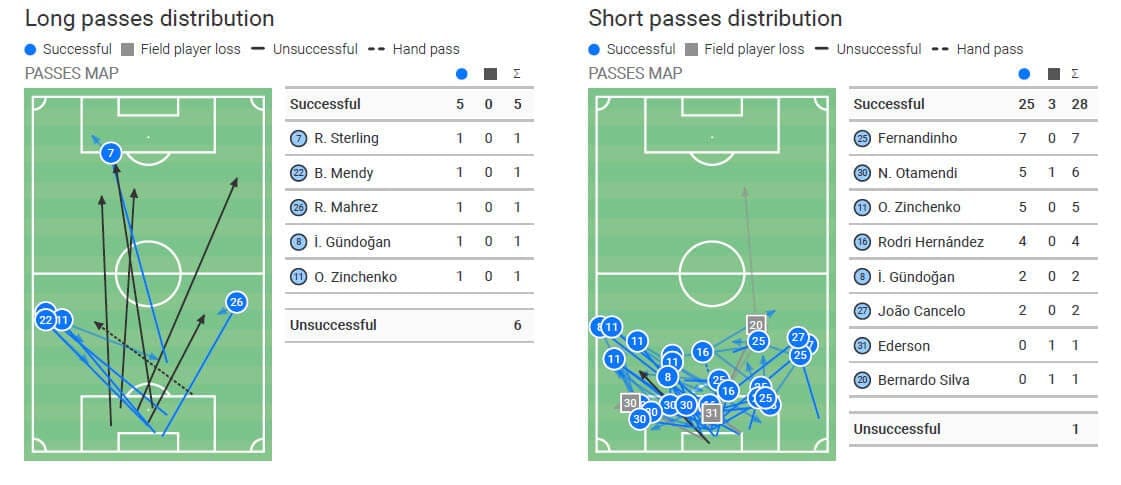
The data above represents Ederson’s distribution in the game. As we can see the high volume of short distance passes (84% of total) were played at to teammates in close proximity even when under pressure. Emphasising Guardiola’s plan to stretch United vertically, play out of pressure, attack through all three-thirds of the field at high-speed and beat the unlocked United defence to get success.
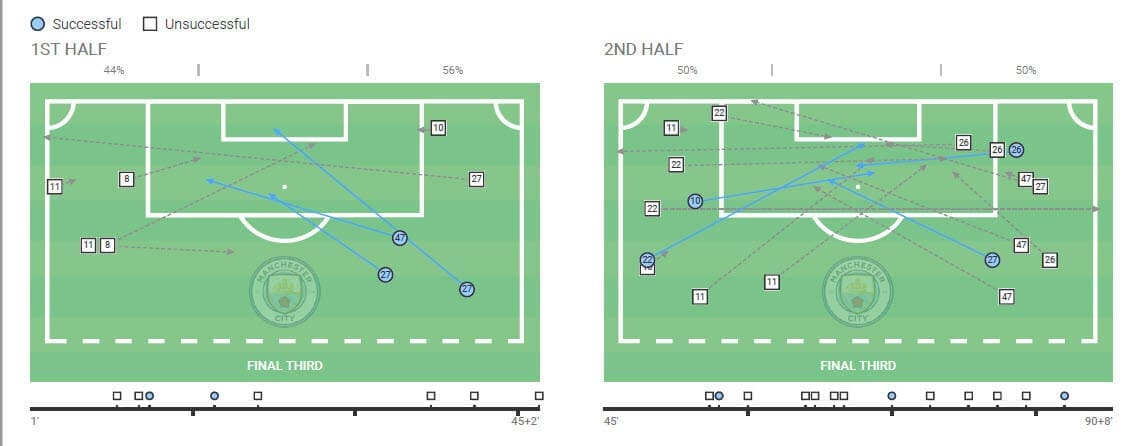
Above, we see Manchester City’s ‘cross-map’ throughout the game. Observe all the different crossers and various crossing positions City executed from. The blue lines represent successful crosses met by teammates while represent crosses defended by the opposition. It was not the fault of the crosser that returned such low success but the quality and organisation of the defence that had more to say on this outcome. Considering Manchester City placed some significance on crosses when accounting for their targeted success, we can better understand why City had such a low xG rating of 0.61.
Sterling exploits the weak side
Already with a tally of 26 goals and 12 assists for the season, Sterling was looking to improve on his output in the final third. The young English forward opted for a high-wide starting position before attempting to carry the ball into the United box. Sterling seems to be at his best when he picks up the ball on the opponents weak-side and drives at the last defender, and that is how Man City attempted to get success on the left side initially.
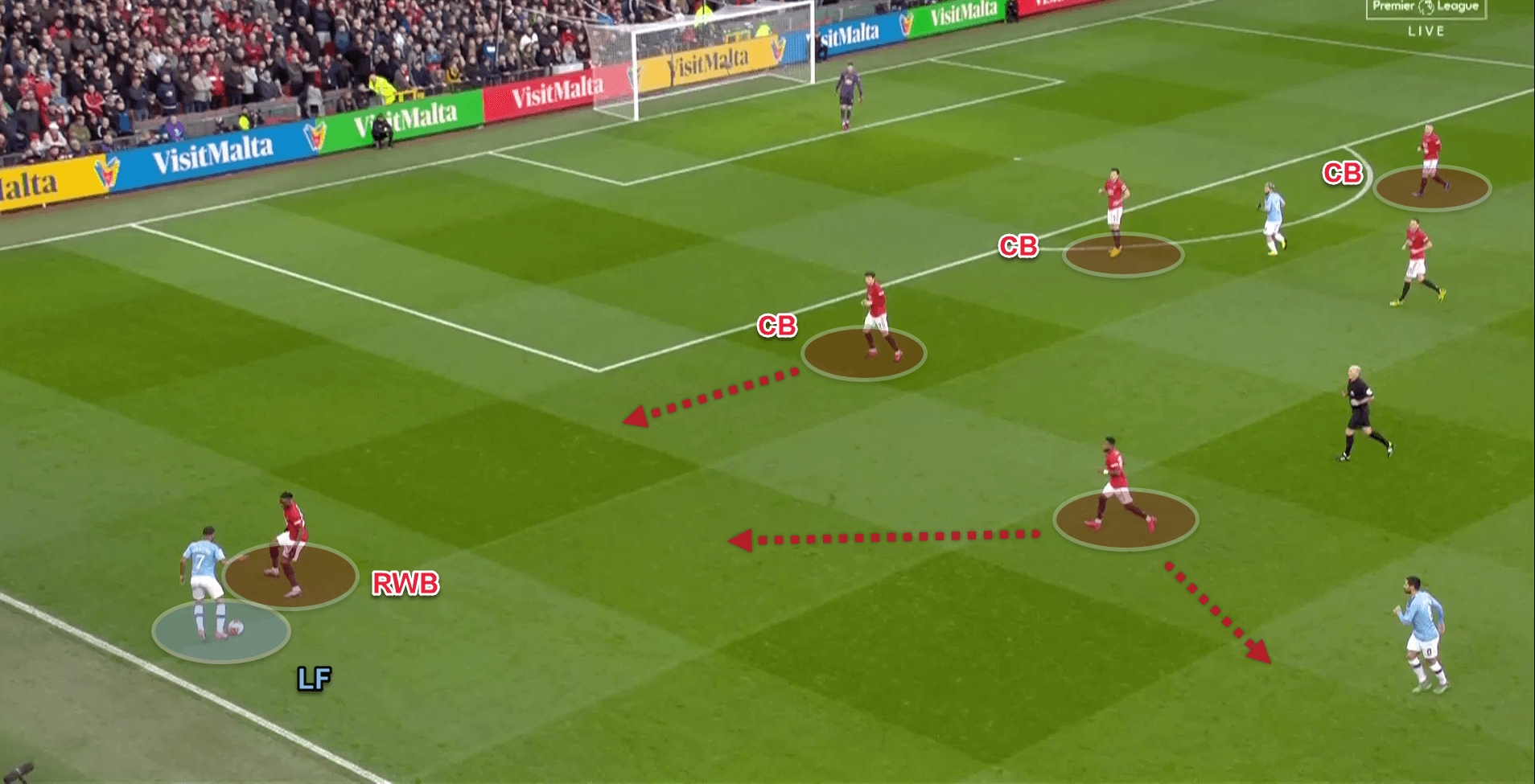
Above we see Sterling has just received the ball moments after City attacked the opposite flank. Sterling is closed down early and met by Man United’s right-wing-back Aaron Wan-Bissaka. Usually, the City frontman is afforded more space by attacking a ‘back four’ however, with United opting to set up with five at the back, and the pacey Wan-Bissaka as his opposite number, Sterling’s chances of success were reduced. This is an area of the field we are used to seeing Sterling affect the game positively. Still, with just two successful dribbles in seven attempts, the Englishman’s 29% dribble success rate was not enough to create any considerable attacks or breach the United goal from the left.
United’s back five neutralise the City attack
It was clear from the beginning Solskjær did not set his team up to play champagne football or match City for any of their strengths. Instead, United conceded both territory and time on the ball to lockout the Sky Blues and catch them on the break. Perhaps not enough praise and acknowledgement is given to teams who defend superbly and make their few chances count, but the home side did so masterfully. Organised in a 5-3-2 formation, United made themselves almost impossible to beat while they enacted their few sound defensive principles of screening, pressure, cover, distances between players and concentration for 90 minutes.
United cover the half-space run
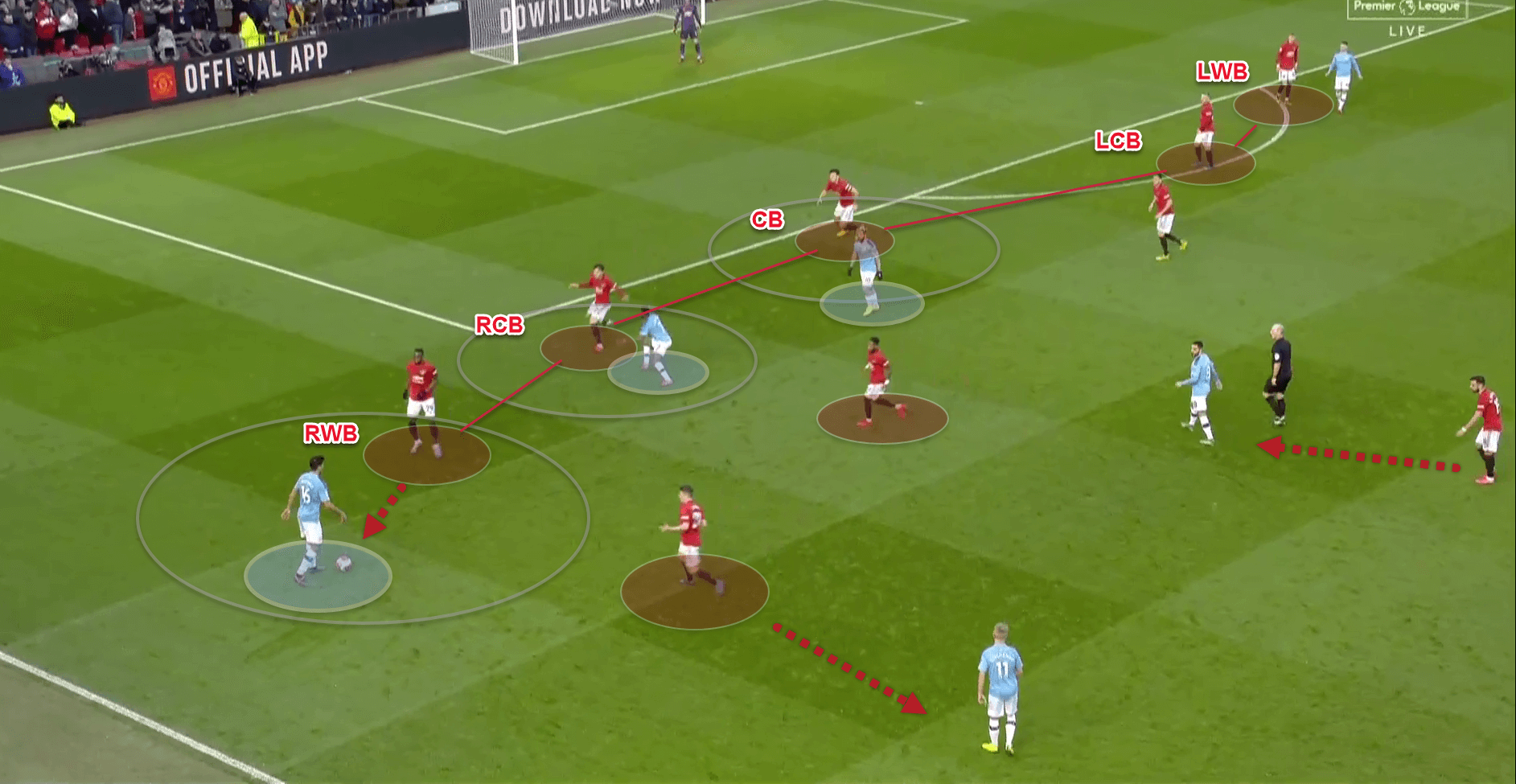
A snapshot above shows the discipline and organisation of the Manchester United backline. Relative to the position of the ball carrier, United offer numbers and pressure out wide while still being organised centrally. ‘RWB’ presses the ball carrier while “RCB’ Victor Lindelöf matches Sterling in the half-space as ‘CB’ Harry Maguire closes down Agüero on the edge of the box. Notice how ‘LCB’ and ‘LWB’ Luke Shaw and Brandon Williams remain balanced to meet any crosses to the back post.
No weak-side in the back five
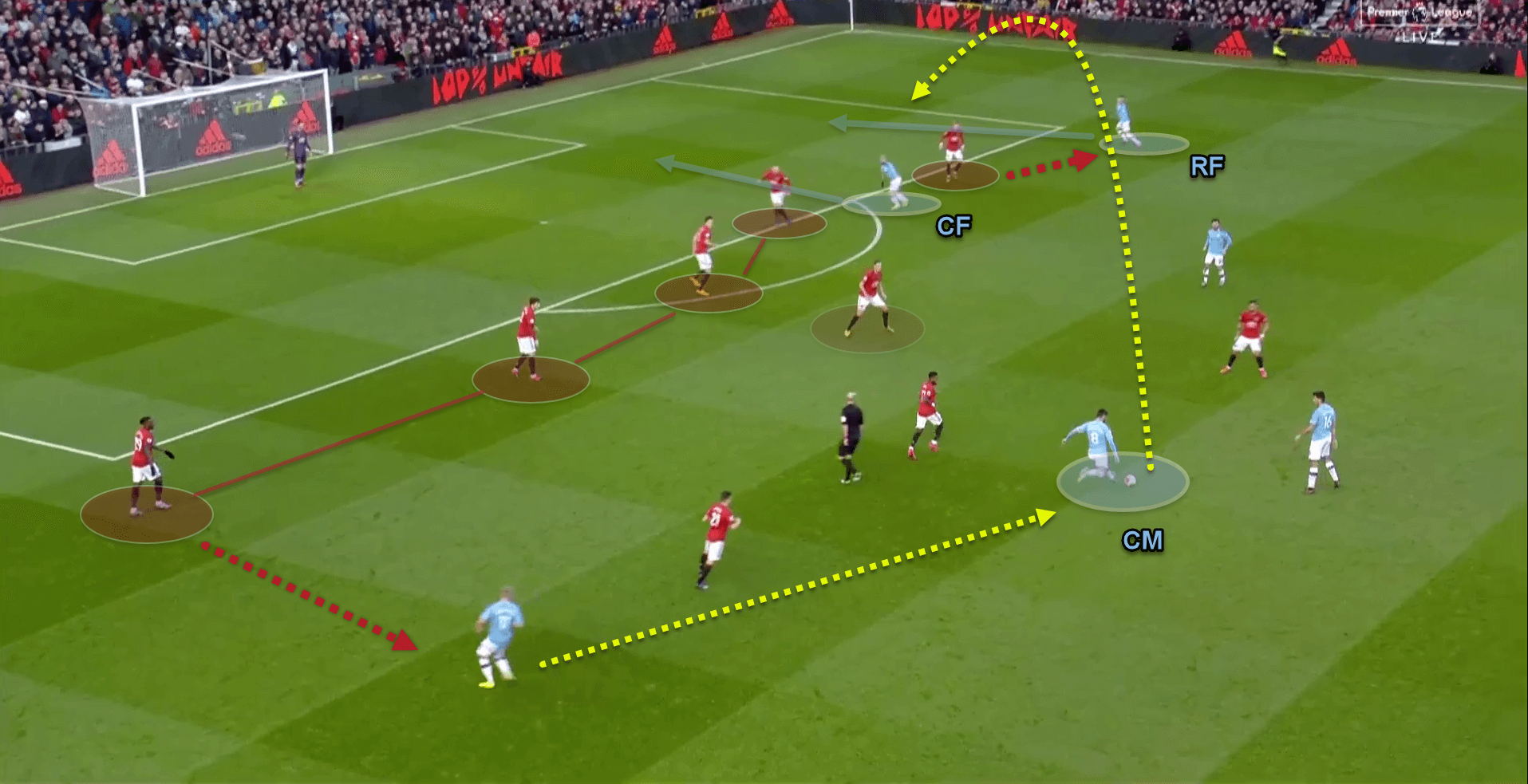
Generally, when teams mount a high attack on one side of the opponents final third, the other side is what we call ‘the weak-side’ because there are fewer players and the opposition defence are not organised momentarily. The men in red were prepared and organised for these attacking initiatives as they were not willing to afford City any opportunity from these areas.
Above, we see Zinchenko has just played a pass centrally from the left which is then crossed to the opposite side for Agüero and Foden to attack. Because united are ready in anticipation of the distances between the five players of the backline is optimal to defend that ball.
Matić screens the backline
Nemanja Matić played centre-midfield for united where he was positioned just in front of the defence and slightly behind his teammate Fred in centre-midfield. Matić had a crucial role in denying City the chance to create dangerous attacks centrally. Players in this role do not always stand out, and it is easy to overlook their significance in the team. Matić screened his defence quite well, and City got little success by way of playing penetrating passes to the forwards or even allowing Agüero to receive passes between the lines. Matić made 9 interceptions against City and was responsible for killing dangerous attacks at their inception.
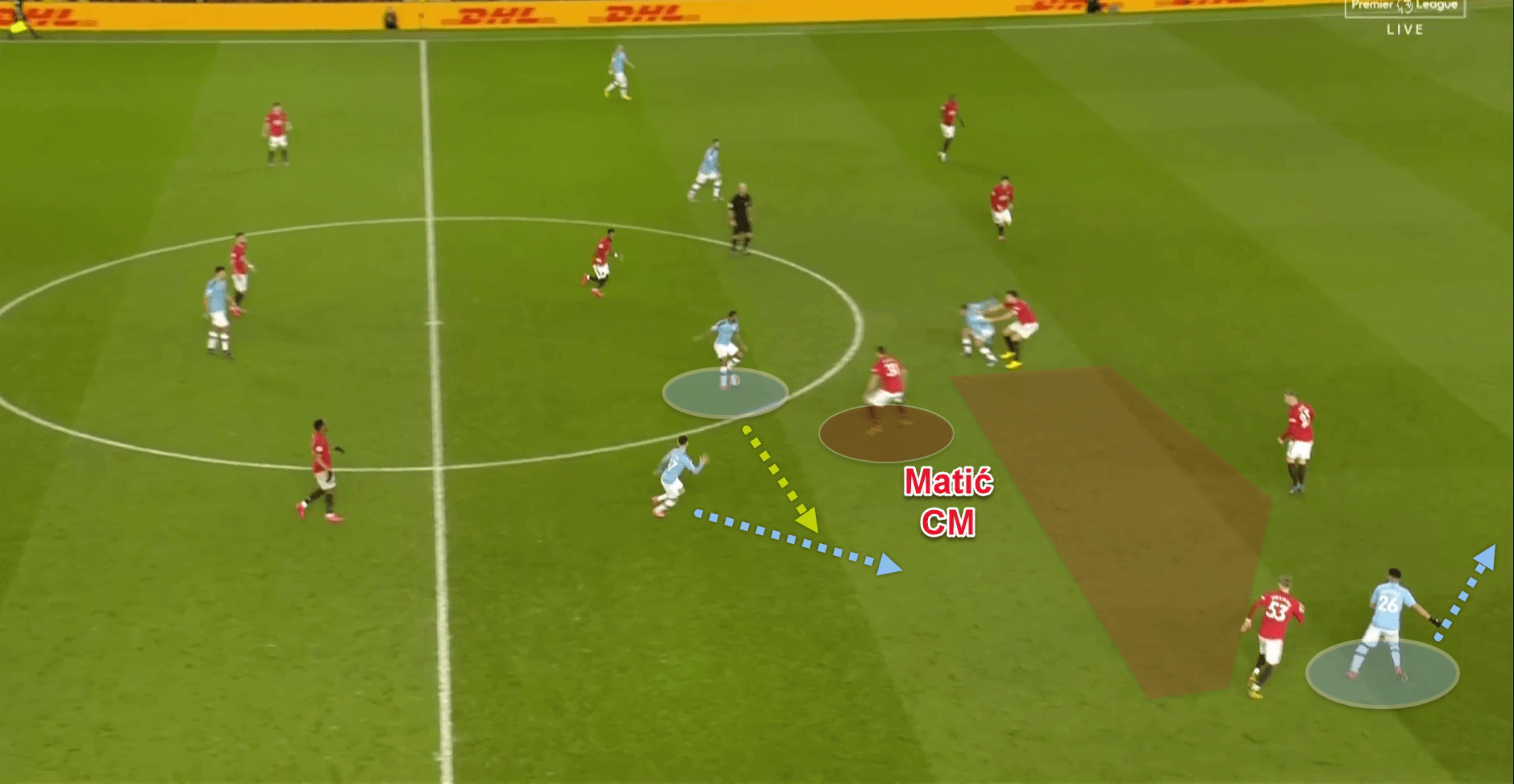
In the image above, Sterling has picked up the ball centrally and is looking to advance the attack forward. The right-forward for Man City Ryad Mahrez makes a run to beat the offside trap and get in behind the United defence. Due to Matić’s positioning Sterling is denied the angles to pass through the gaps, and as a result, he is forced to play horizontally. At this moment, Matić makes an interception which allows United to counter-attack.
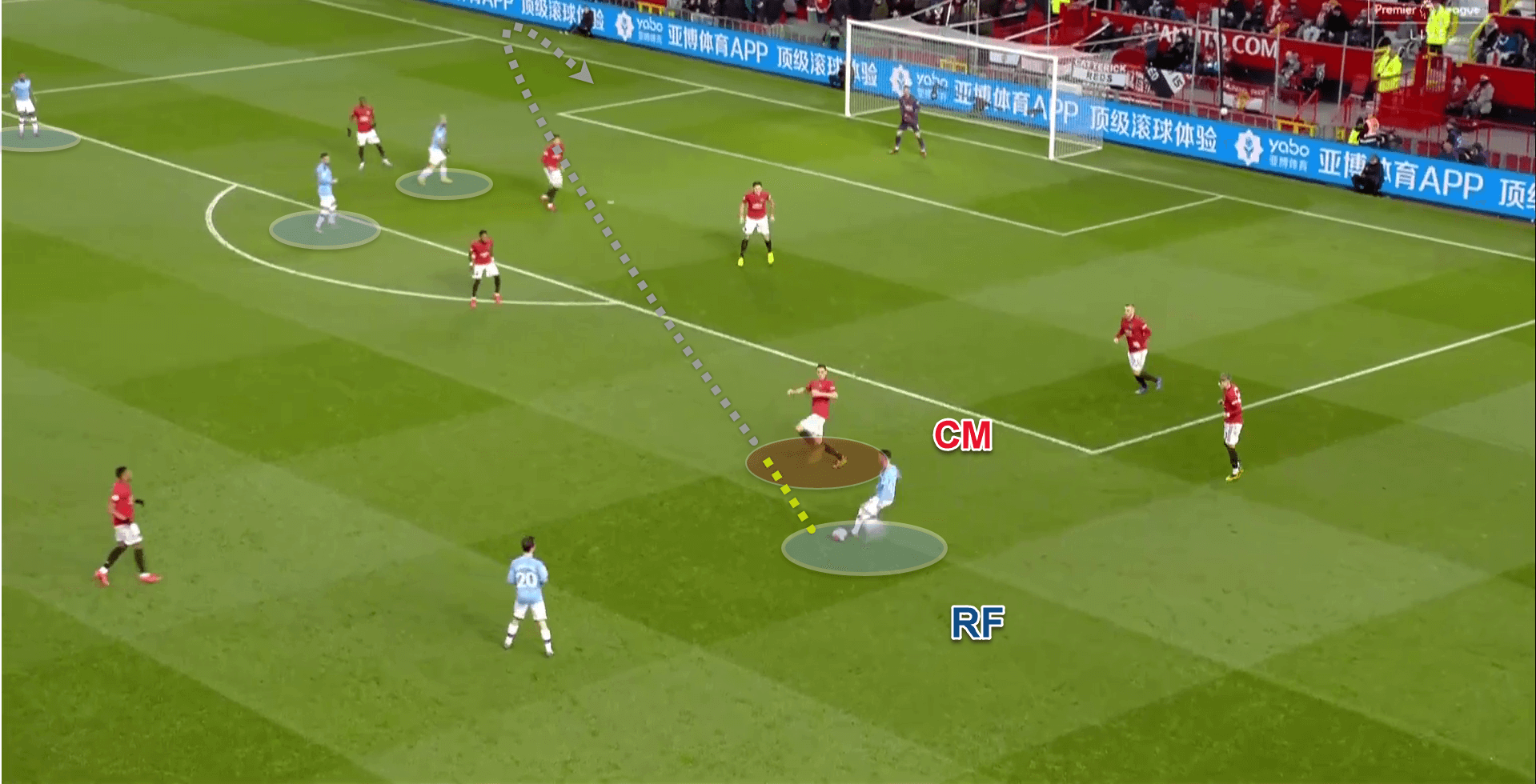
In the moment above, United are defending deep in their box as Foden is aiming to deliver an in-swinging cross to the back post. Matić moves into the correct position to block the cross and does so successfully, once again United mount a charge at a disorganised City defence.
United are direct in transition
As a result of United’s deep defensive shape to soak up the pressure City’s defenders committed themselves high to bolster the attack. However, in the moment’s possession was turned over, the Sky Blues found themselves stretched and working hard to recover as the men in red counter-attacked. United’s defensive shape also served the counter-attack as well as both wing-backs, Wan-Bissaka and Williams were in good positions to support their teammates and offer passing options forward on their runs. Manchester United executed 11 counter-attacks in comparison to City created just two.
Consider this, knowing what we know now, City bested United in possession 70% to 30%. However, in considering the argument of two styles, one to be patient build-up possession football, the other to be direct counter-attacking football, the value in front of goal may determine some conclusion.
Man United had 31 attacks, eight of which resulted in an attempt on goal (26% of their attacks resulted in a shot) while Man City for all the possession they enjoyed had only six shots on goal (10% of their attacks resulted in a shot).
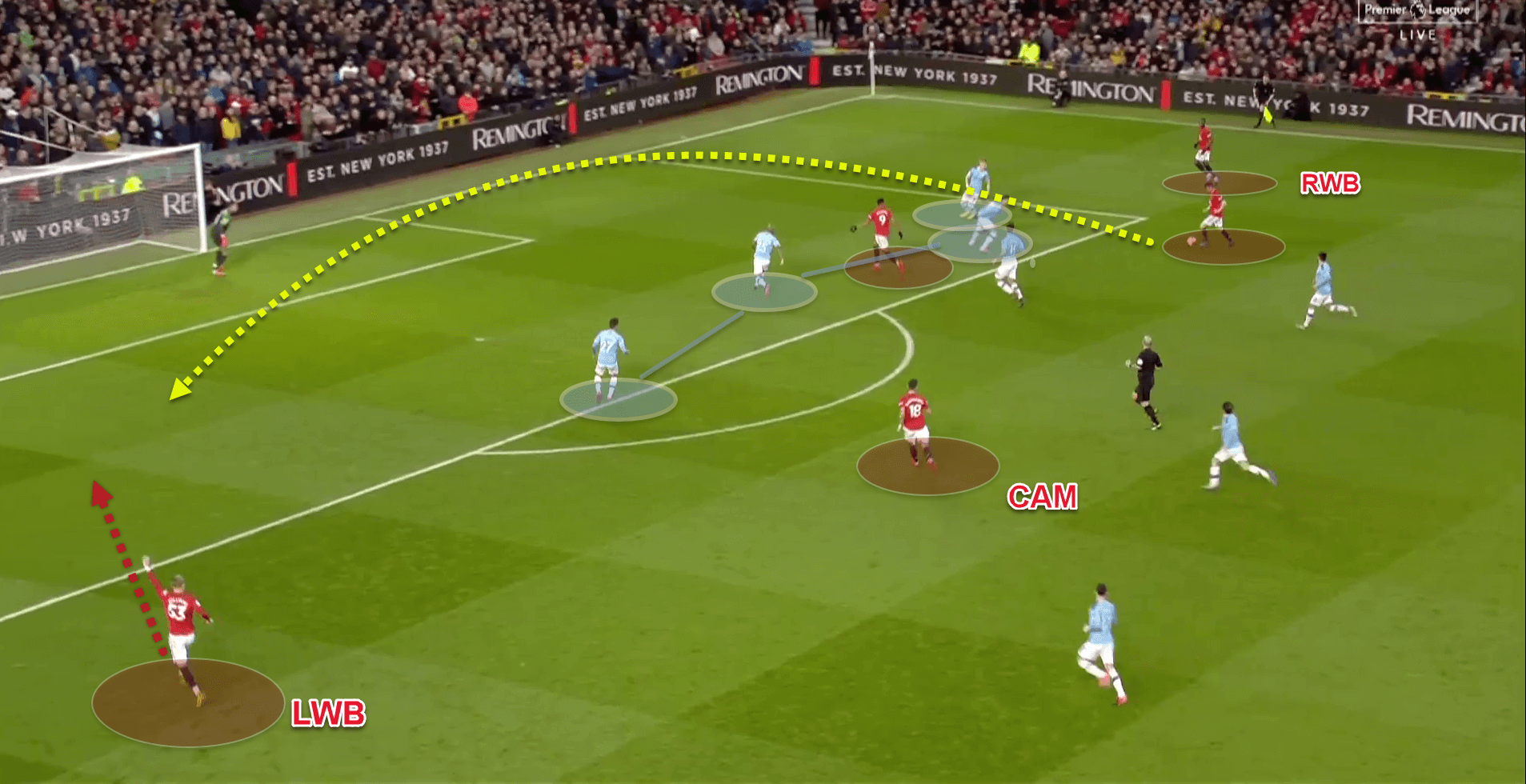
Above, we see an example of how united’s formation served them well both defensively and in attack. United won back possession on the halfway line and counter-attacked immediately. As the play developed down City’s left side, we see Williams make himself an attacking threat on the opponent’s weak side. Credit to the quality and vision of centre-forward Daniel James to identify the run of his teammate and deliver the cross. Williams did not have a great connection when meeting the cross, and as a result, it was a high-value opportunity that went amiss.
Bruno Fernandes and Anthony Martial also played a crucial part in the transition to attack. The Portuguese talisman played some exceptional passes forward to meet the runs of the pacey forwards. But for lack of perfection in the final ball at times United may have had more to celebrate.
United in the build-up
Manchester United had 14 goal kicks in the game, 50% of which were short passes for United to play out from the back. Due to their five at the back, the overload made it easier for United to play into midfield. The three centre-backs would play to the width of the box while the wing-backs would occupy the widest positions on the field. As the ball would reach the wing-back, this is when we would see good movement from the united midfield and forwards to play through the gaps and advance the attack.
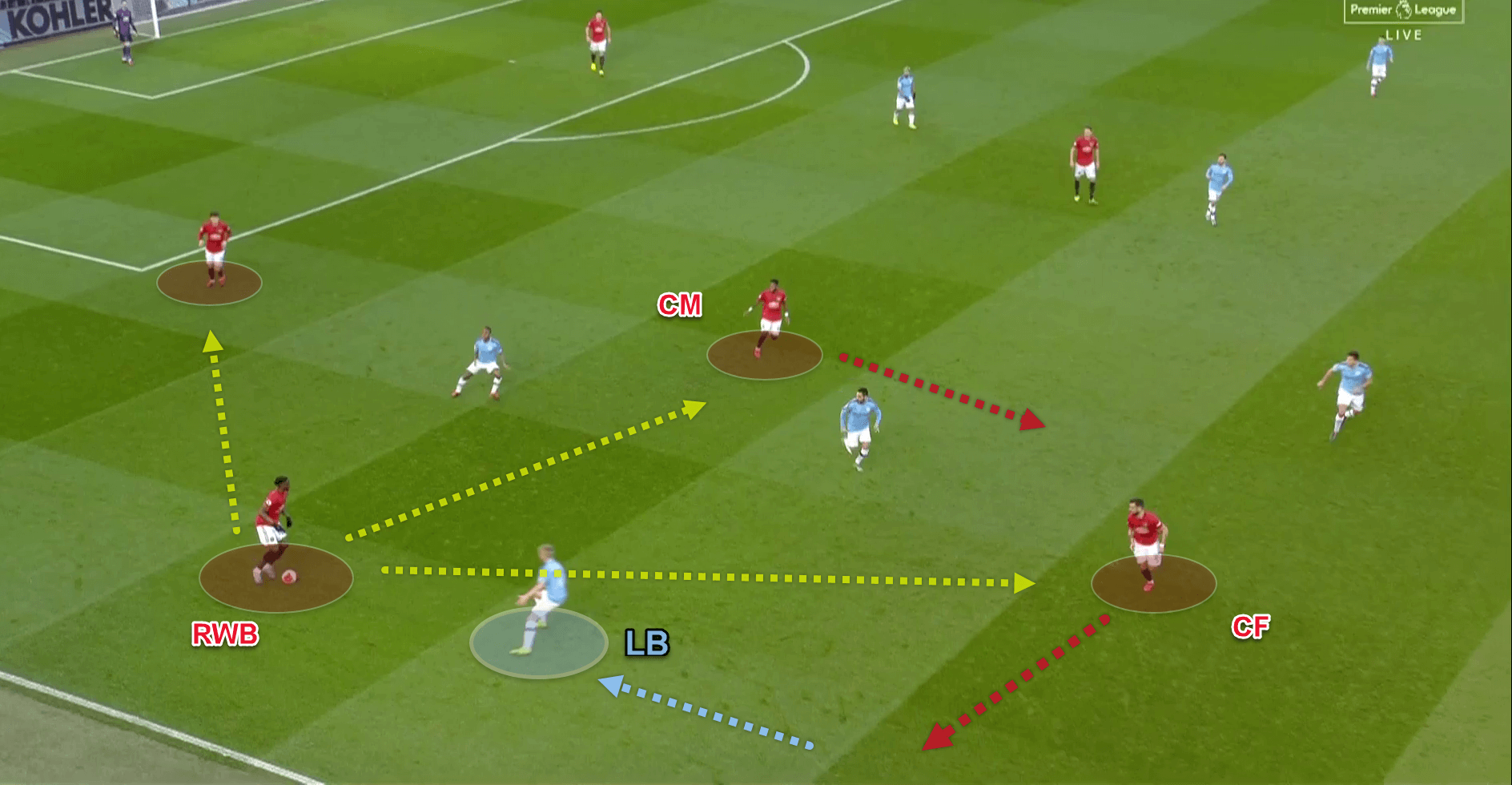
In the image above, we see the movement of the United forward to exploit the space made available by the City defender. As Wan-Bissaka receives the ball from his teammate, he has multiple options to play forward, centrally or back. When the opportunity to play forward was on the wing-backs would play into the channels where either Martial, Fernandes or James would meet the pass.
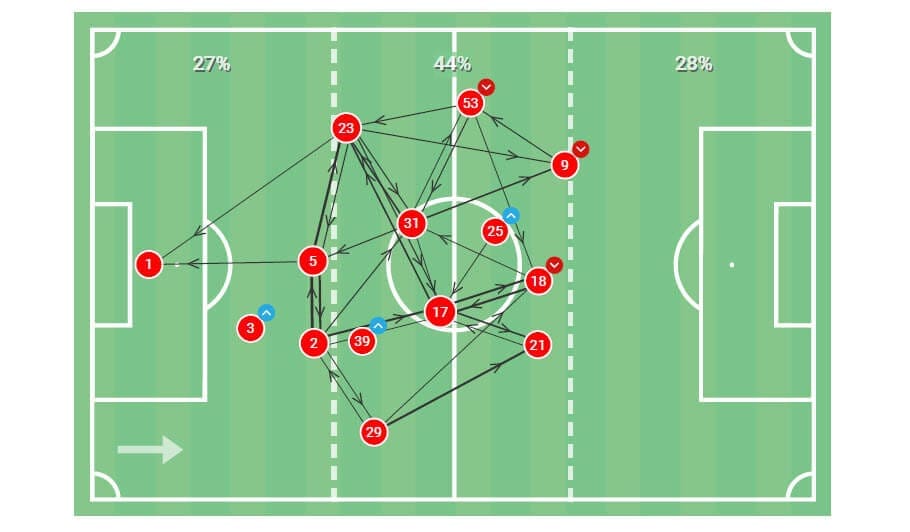
The data above shows the Man Utd pass network. The data accounts for combinations of three or more passes as well as each player’s average position when in possession. We see United did not opt for more patient build-ups in comparison to their opponents, as this would have shown by having denser lines between the defenders and the midfield. Also considering Man City’s PPDAto be an average of 7.2, it further helps out understanding of United’s direct approach.
United’s high-press
Before City had a chance to develop prominent attacks and reach United’s final third, the reds set up to win possession on their goal kicks. Committing the front five players to the press as well as the wing-backs united pressed aggressively although they were unable to force City into making errors in front of their own goal. Thye did, however, achieve secondary success forcing City’s full-backs to play long, inaccurate passes at times which resulted in a turnover in possession for the reds.
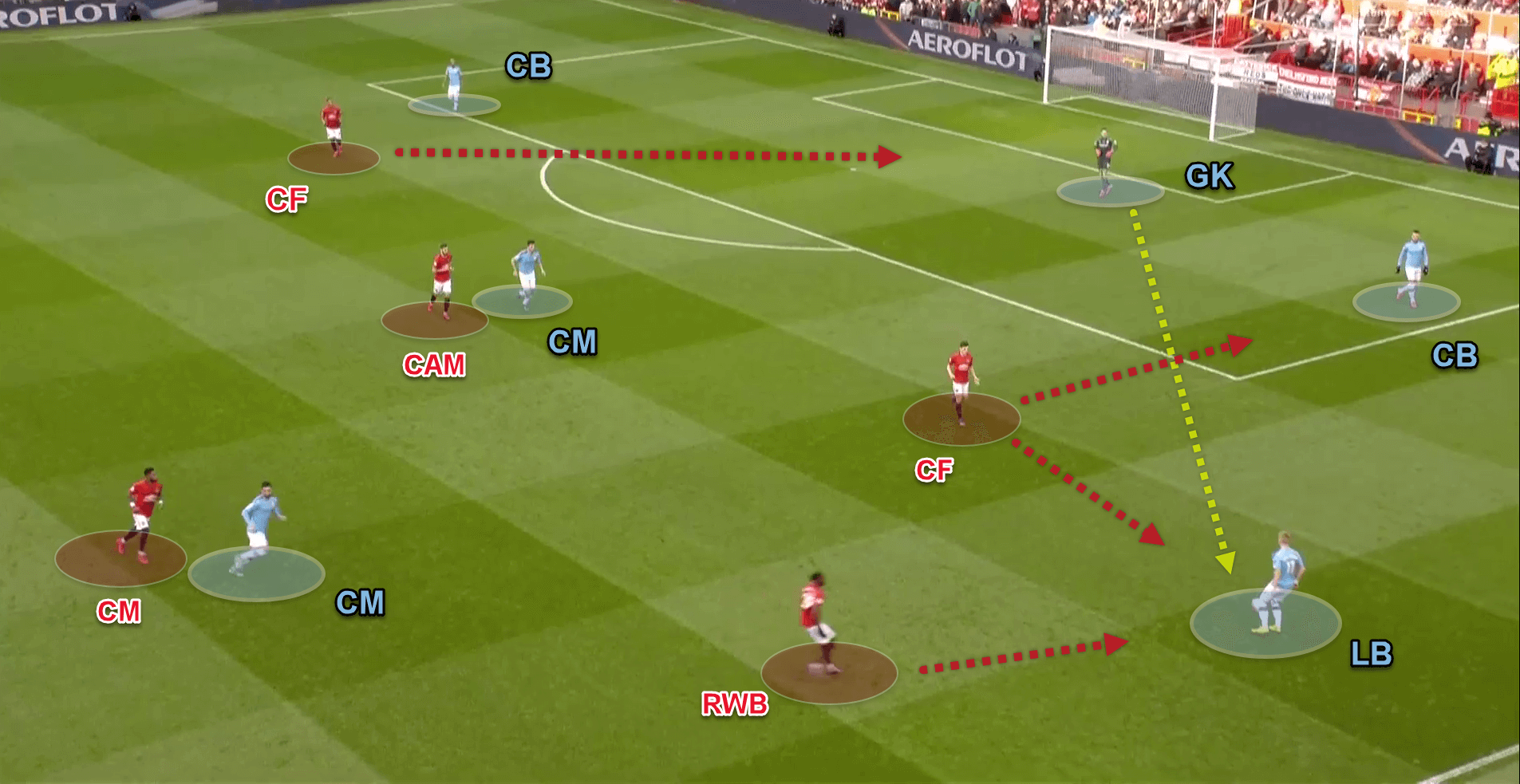
In the image above, we see United press City on their goal-kick. Ederson plays to the left-back Zinchenko who pressed immediately by Wan-Bissaka. City had no problem playing back into their own box to find an outlet on the other flank.
Pep prioritises pace
On 59 minutes Pep Guardiola makes his first two substitutions for City. The top goalscorer Agüero is withdrawn along with attacking midfielder Bernardo Silva. To be replaced by Jesus and Mahrez who along with Sterling made up City’s front three for the remaining 30+ minutes. To take off his prolific goalscorer so early in the game indicated he needed to tweak things tactically to penetrate the back five of United. A decision that that was clear and obvious, winning the foot race against the defence.
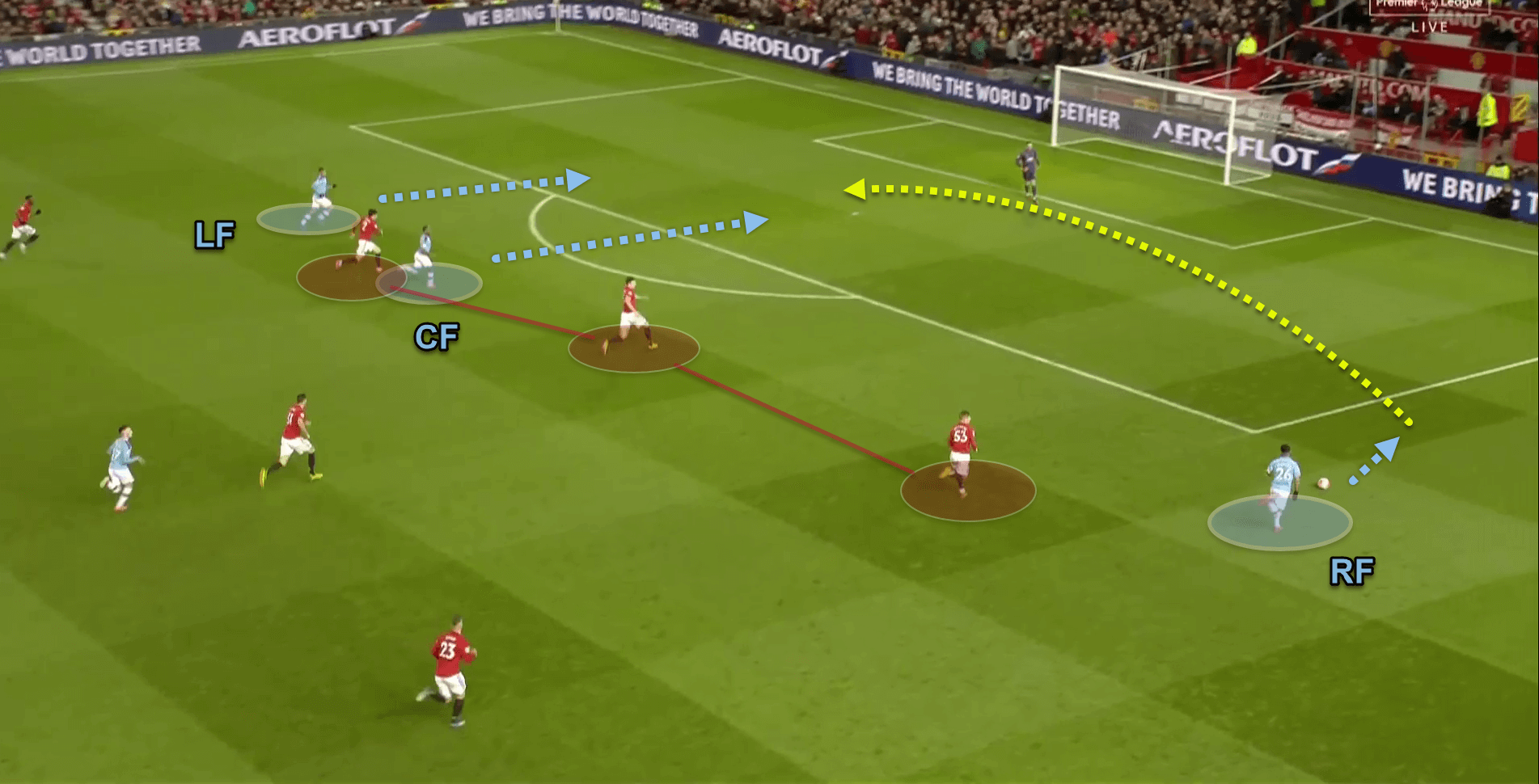
City’s attacking prowess enhanced intermittently, particularly when the Citizens opted for counter-attacks in transition. Above we see the type of threat Mahrez, Sterling and Jesus pose as a front three. Moments earlier holding midfielder Rodri played a through ball to mee the run of Mahrez and withing second he was already out or frame. City could not make this opportunity count and they were unfortunate not to create more similar chances to counter-attack. Perhaps too much patience in the build-up when you have such a deadly frontline was what cost Guardiola his good fortune.
A chess match of substitutions
Excuse the hyperbole, however, there is a significant point to address in how teams fortunes could have changed late in the second half. Guardiola changed his front three on 60 minutes and dropped Foden into midfield as a playmaker; this almost paid huge dividends but for lack of perfection in the final ball when the pacey forwards combined.
Although it was not until the 78 minutes we saw another tactical move and counter move from both managers. To change the point of attack in order to get success, Guardiola introduced Benjamin Mendy to the game at left-back in a like for like substitution with Zinchenko. Mendy’s function in the game was to deliver dangerous crosses into the box where City began to overload the penalty spot. At the same time, in recognising City’s initiative, United boss Solskjær introduced 6ft2 Eric Bailly as a centre-back to nullify this threat and the counter move worked well. Mendy delivered five crosses into the box where only one was successfully challenged, meanwhile, Bailly won 100% of his defensive duels.
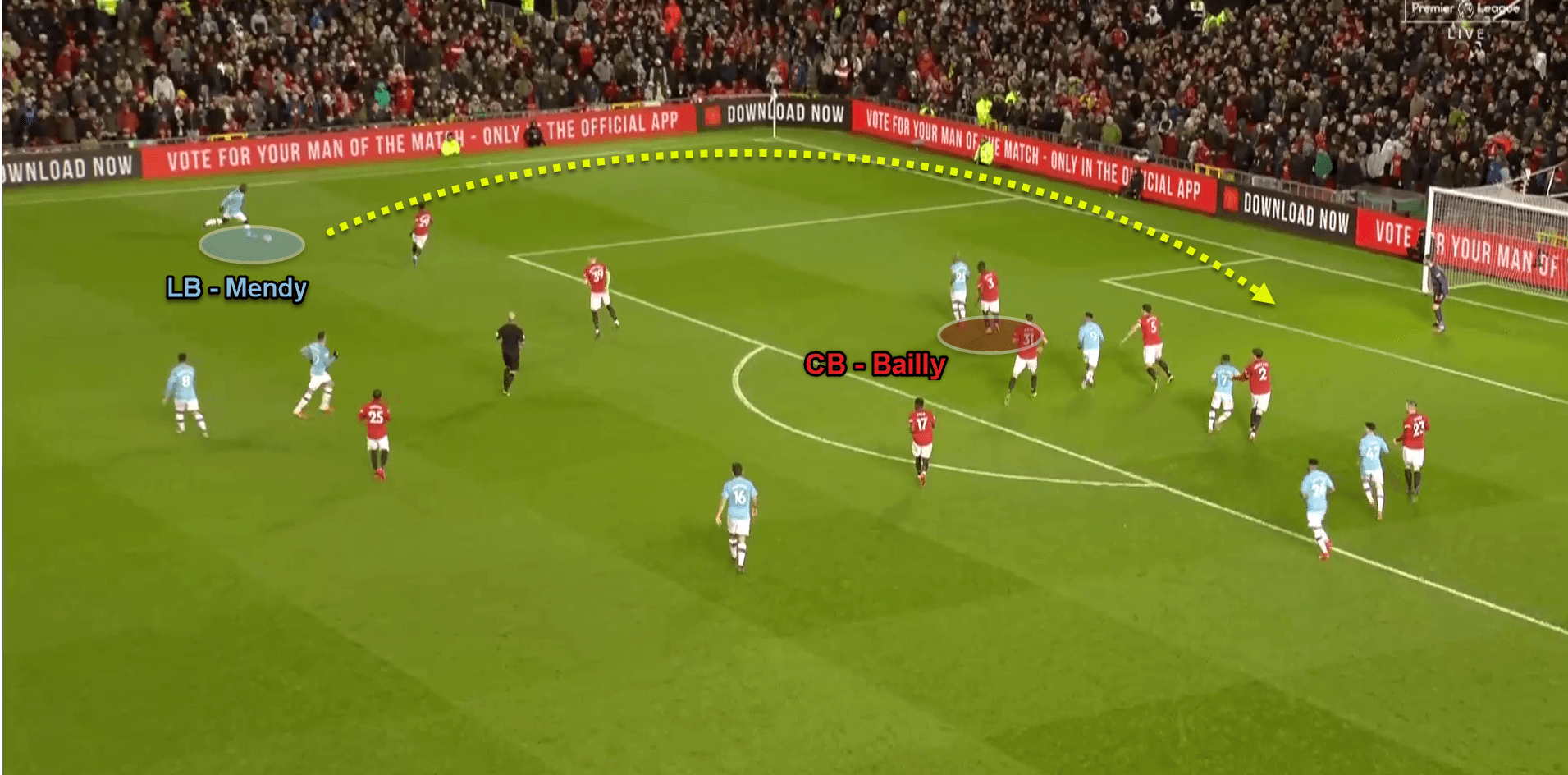
In the above image, we see Mendy aiming a cross for any one of the four City players in the box to attack. Bailly marks the highly advancing Fernandinho so he has no ariel dominance should he meet to contest the cross.
Credit the tactical acumen for the United boss to make such a significant change in a time of the game City were pressing hard for the equaliser.
Ederson’s errors seal City’s fate
Whether goals are conceded in open play or by set-piece, responsible analysis is really to identify and accounted for the string of errors before the easiest error to blame, the goalkeeper.
For the first goal on 30 minutes, City’s defence was switched off as Fernandes played a cute and clever chip into the run of Martial. Martial needed only one touch to strike low, however, although the low shots are difficult to save at close range Ederson already got down low and let it slip through his hands.
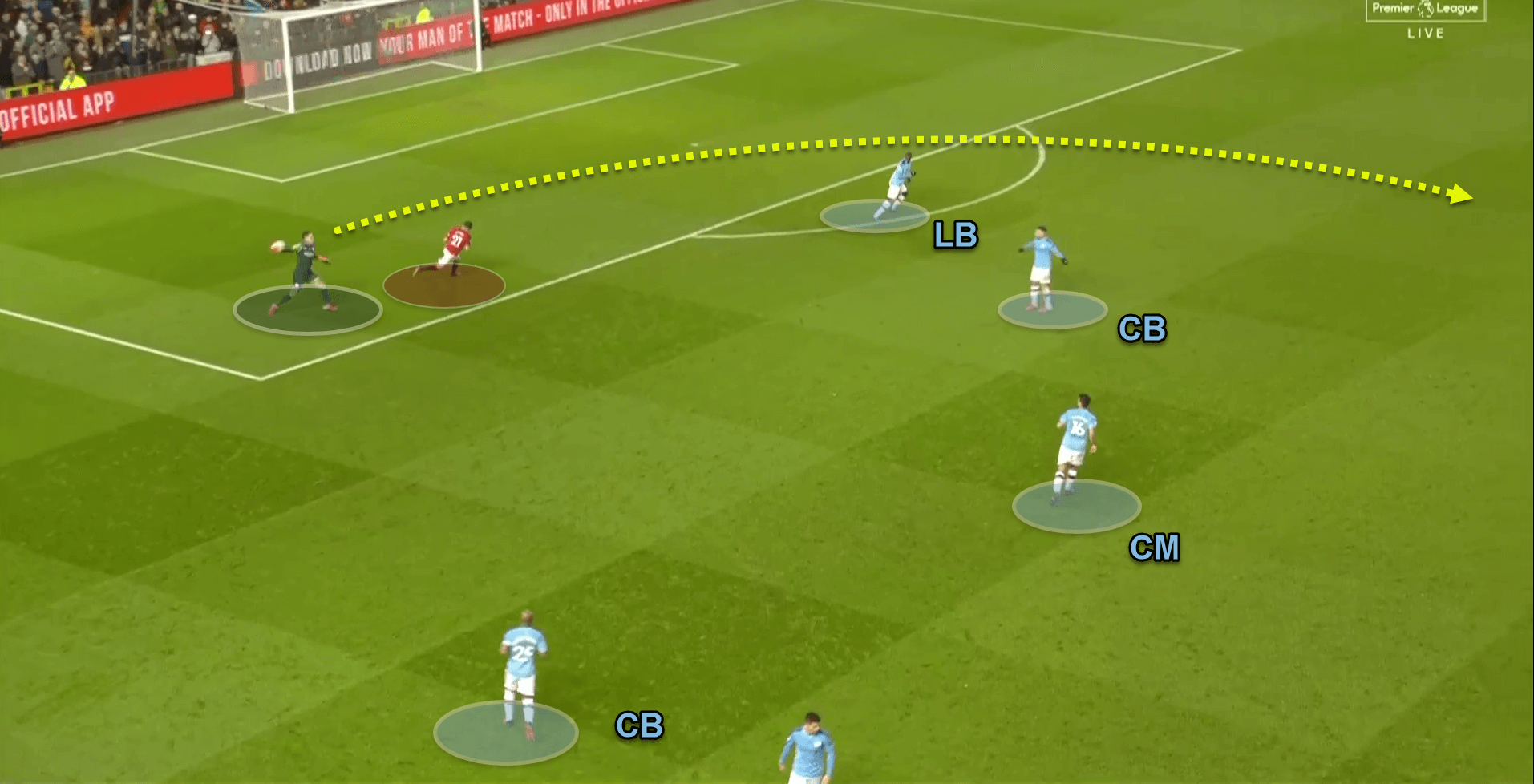
For the second goal on 96 minutes, It was the distribution in the image above that went straight to the feet of the United striker McTominay who finished from a distance on his second touch. Heavy rain was pouring at this time, so we are not aware if that is a factor for consideration such that Ederson has lost grip of the ball. Nonetheless, City all game had played on a knifes edge of pressure playing out in front of their own goal, considering all of Ederson’s options directly in front of him his choice should have been simple and routine.
Conclusion
It seems to be part of the story for Man City’s season, dominating games only to find their heads buried in their hands at the final whistle. We can be sure that the Guardiola will treat both this game and this season as a tremendous learning opportunity.
Solskjær along with the red half of Manchester will live in the moment and revere in this huge achievement, as they tell the blue half of Manchester, recent years have been kind to you, but today we do not live in your shadow. The United defence was exceptional to reduce the threat of City and keep out the danger for 90 minutes. This result will no doubt give the United dressing room a huge confidence boost as closing ten games of the season commence.
The Sky Blues have a chance to put the defeat behind them and move forward as early as Wednesday, as the Sky Blues welcome Mikel Arteta’s Arsenal to the Etihad for their 29th league game of the season. Meanwhile United put domestic action on hold as they travel away to Austria to play LASK in the round of 16 of the Europa League.
To follow all the action and get a comprehensive analysis of both of these teams, be sure to follow us here on totoalfootballanalysis.com.





Comments